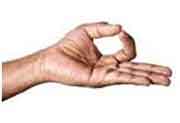 |
1. Gyan Mudra : The Gyan Mudra, also known as Chin Mudra, This Mudra is formed by joining together the tip of the index finger with the tip of the thumb.
Benefit: Creation of a Pranic circuit, which maintains and redirects the “Prana” or the flow of energy within your body. Improvement and increase in concentration, even during meditation. Increasing energy and stamina. Promotion of better sleep patterns. Reduction of common ailments like lower back pain. Relieving stress and any unnecessary tension in the body. Stimulation of the energies based at the Mooladhara Chakra.. |
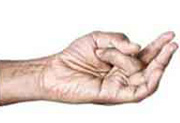 |
2. Shoonya Mudra :Press the middle finger on the base of the thumb and keep the thumb on middle finger. Keep the other three fingers straight
Benefit: Relief in diseases and pains relating to the ear. |
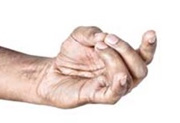 |
3. Apaan Mudra :Join the tip of the thumb with the tip of middle and ring finger, keeping the other finger straight.
Benefit: Helps in clearing the body by elimination of waste matter from the mouth, eyes, ears, nose etc.
Helps when urine is obstructed, reduces constipation. |
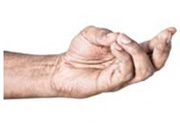 |
4. Prana Mudra :Join the tip of the thumb with tip of little and ring finger. Keeping other two fingers straight.
Benefit: Helps in pumping the life force into your body. Beneficial for all types of diseases. Imparts special power to the eyes. |
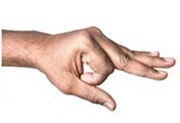 |
5. Vayu Mudra:This mudra is formed by first placing the tip of the index finger on the base of the thumb and then bringing gentle pressure of the thumb upon this finger.
Benefit: Helps in diseases like arthritis, trembling in Parkinson’s disease. Better results obtained if practices after Prana mudra. |
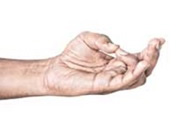 |
6. Prithvi Mudra (Prithvi vardhak): Join the tip of the thumb and ring finger.
Benefit: Makes body sturdy. One experiences happiness. |
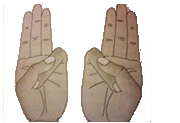 |
7. Jal Shamak Mudra: This mudra is formed by first placing the tip of the little finger on the base of the thumb and then bringing gentle pressure of the thumb upon this finger.
Benefit: Reduces edema (water-retention) &, dropsy, excessive salivation, watery eyes, running nose. |
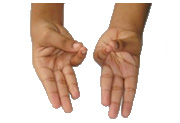 |
8. Varun Mudra (Jal Vardhak):
This mudra is formed by joining together the tips of the thumb and the little finger.
Benefit: It increases the water content in the body (helps in hydration), reduces dryness. People who have edema should not perform this Mudra. |
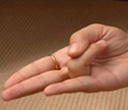 |
9. Surya Mudra (Prithvi Shaamak): This mudra is formed by first placing the tip of the ring finger on the base of the thumb and then bringing gentle pressure of the thumb upon this finger. This amounts to suppression of element earth (residing in the ring finger) by element fire (residing in the thumb). The earth element thus suppressed, fire is able to rage unopposed.
Benefit: Reduces weight of your body, controlling obesity, reduces the symptoms of loss of appetite, indigestion, constipation. |
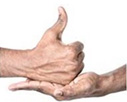 |
10. Linga Mudra: Interlock the fingers of both hands together. Keeping the left thumb up (encircled by right thumb and index finger) i.e. left thumb should be vertically straight and right thumb around it.
Benefit: Produces heat in the body and helps in curing cold and cough. |
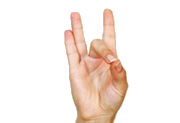 |
11. Akasha Mudra: This mudra is formed by joining together the tips of the thumb and the middle finger.
Benefit: Helps -to develop noble & elevated thoughts, To develop intuition and extra sensory powers (ESP), To detoxify the body by the elimination of metabolic wastes (through exhaled air, sweat, urine and stools), To overcome a feeling of fullness / heaviness in the body or body-parts. |
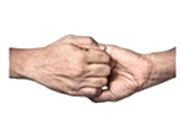 |
12. Ganesha Mudra: Position the left hand with the palm facing outwards in such a way that your thumb points towards your solar plexus and your little finger points towards your collar bone. Form a claw by bending the four fingers of your left hand and clasp them with the four fingers of your right hand. In this position, your right palm should be facing towards your chest. Repeat this.
Benefit: The benefits of the Ganesha Mudra extend to the cardiac muscles, the muscles of the chest, shoulders, and arms. It also helps to release any pent up tension from the shoulders and chest. |
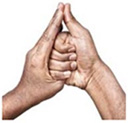 |
13. Shankh Mudra: Raise both your arms in front of your chest. Wrap all four fingers of your right hand around your left thumb. Bring the tips of your right thumb and left middle finger together. The other fingers off your left hand should be parallel to the middle finger. Your hands will form a shape like a conch shell, which is where the Shankh Mudra gets its name from.
Benefit: One of the most important benefits of the Shankh Mudra is the positive effect that it has on the respiratory system. It also helps to calm and center the mind. |
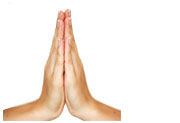 |
14. Anjali Mudra: Anjali mudra is performed by pressing the palms of the hands together. The fingers are together with fingertips pointing up. The hands are pressed together firmly and evenly.
Benefit: Anjali mudra is performed as part of a physical yoga practice with an aim to achieving several benefits. It is a centering pose which helps to alleviate mental stress and anxiety and is therefore used to assist the practitioner in achieving focus and coming into a meditative state. The physical execution of the pose helps to promote flexibility in the hands, wrists, fingers and arms. |
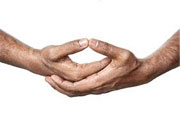 |
15. Dhyana (Bhairav) Mudra: The Dhyana mudra ("meditation mudra") is the gesture of meditation, of the concentration of the Good Law and the saṅgha. The two hands are placed on the lap, right hand on left with fingers fully stretched (four fingers resting on each other and the thumbs facing upwards towards one another diagonally), palms facing upwards; in this manner, the hands and fingers form the shape of a triangle, which is symbolic of the spiritual fire or the Triratna (the three jewels). This mudra is used in representations of the Śākyamuni Buddha and Amitābha Buddha. Sometimes the Dhyāna mudrā is used in certain representations of Bhaiṣajyaguru as the Medicine Buddha, with a medicine bowl placed on the hands. It originated in India most likely in the Gandhāra and in China during the Wei period. This mudra was used long before the Buddha as yogis have used it during their concentration, healing, and meditation exercises. |
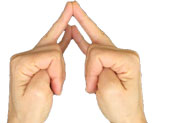 |
16. Shakti Mudra: Shakti Mudra is a hand gesture which ensures numerous mental as well as physical advantages. The word “Shakti” means empowerment or power and “Mudra“ is a form of expression by using the fingers of both hands. It is good for triggering sound sleep and relaxation. This mudra helps those suffering from insomnia by fighting psychological stress and relaxing the body. It relaxes the pelvic area of a person and counteracts spasms in the intestines. Moreover, it helps ladies during menstrual problem.
Benefits: Shakti Mudra helps those suffering from chronic insomnia by relaxing the body. It’s improving sleep and providing desired outcomes in insomnia and other sleeping disorders. This mudra also helps to increase the mental and physical energy. This mudra calms the mind and the nervous system. It provides relaxation in the pelvic area of an individual. Shakti Mudra also prevents spasms in the intestines in a male body. It also helps in the menstrual disorders in female body. |
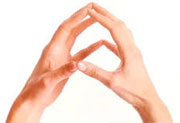 |
17. Hakini Mudra: The Hakini Mudra in Yoga can be described as a gesture in which you need to join the tips of the five fingers on your right hand, with those of the left. It is said that this mudra, which is named after the God Hakini, helps boost thinking and concentration. It is believed that this gesture is linked to the Third-Eye Chakra, where your imagination and intuition are located.
Benefits: Improvement in concentration and memory, Promotion of coordination between the left and right hemispheres of the brain, Creation of a sense of calmness, which opens the mind to clearer thinking. |
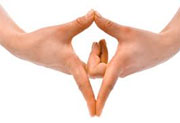 |
18. Yoni mudra: The Yoni mudra can be described as a gesture that allows a person to get detached from the chaos of the outer existing world. Yoni means uterus or womb and this gesture is named the Yoni Mudra, because the person who practices it regularly has no external contact with the world, pretty much like a baby in the uterus.
Benefits: Relieving stress, Relaxation and rejuvenation of the mind. Stabilizing the nervous system. Maintaining a state of mental clarity and relaxation.
Attaining spiritual calmness and mental development. |
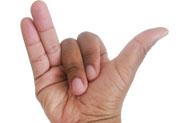 |
19. Vishnu Mudra: This is one of the hand gestures used to alternate the breath through the nostrils during Nadi Shodana. Index and middle finger rest on the palm. The thumb and fingers rest lightly just above the nostrils so very little movement is needed to close each side during practice..
Benefits: Used for nadi shodhana pranayama. |

